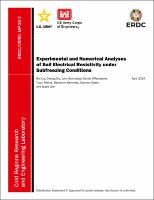Please use this identifier to cite or link to this item:
https://hdl.handle.net/11681/48430| Title: | Experimental and numerical analyses of soil electrical resistivity under subfreezing conditions |
| Authors: | Liu, Rui Zhu, Cheng Schmalzel, John Offenbacker, Daniel Mehta, Yusuf Barrowes, Benjamin E., 1973- Glaser, Danney R. Lein, Wade A. |
| Keywords: | Frozen soil Electrical resistivity Finite element modeling Freeze–thaw |
| Publisher: | Engineer Research and Development Center (U.S.) |
| Series/Report no.: | Miscellaneous Paper (Engineer Research and Development Center (U.S.)) ; no. ERDC/CRREL MP-24-2 |
| Is Version Of: | Liu, Rui, Cheng Zhu, John Schmalzel, Daniel Offenbacker, Yusuf Mehta, Benjamin Barrowes, Danney Glaser, and Wade Lein. "Experimental and numerical analyses of soil electrical resistivity under subfreezing conditions." Journal of Applied Geophysics 202 (2022): 104671. https://doi.org/10.1016/j.jappgeo.2022.104671 |
| Abstract: | The engineering behavior of frozen soils is critical to the serviceability of civil infrastructure in cold regions. Among various geophysical techniques, electrical resistivity imaging is a promising technique that is cost effective and provides spatially continuous subsurface information. In this study, under freeze–thaw conditions, we carry out lab–scale 1D electrical resistivity measurements on frost–susceptible soils with varying water content and bulk density properties. We use a portable electrical resistivity meter for temporal electrical resistivity measurements and thermocouples for temperature monitoring. Dynamic temperature-dependent soil properties, most notably unfrozen water content, exert significant influences on the observed electrical resistivity. Below 0 °C, soil resistivity increases with the decreasing temperature. We also observe a hysteresis effect on the evolution of electrical resistivity during the freeze–thaw cycle, which effect we characterize with a sigmoidal model. At the same temperature, electrical resistivity during freezing is consistently lower than that during thawing. We have implemented this sigmoidal model into a COMSOL finite element model at both laboratory and field scales which enables the simulation of soil electrical resistivity response under both short–term and long–term sub–freezing conditions. Atmospheric temperature variations induce soil temperature change, and thereby phase transition and electrical resistivity change, with the rate of change being a function of the depth of investigation and soil properties include initial water content and initial temperature. This study advances the fundamental understanding of the electrical behaviors of frozen soils and enhance the application of electrical geophysical investigations in cold regions. |
| Description: | Miscellaneous Paper |
| Gov't Doc #: | ERDC/CRREL MP-24-2 |
| Rights: | Approved for Public Release; Distribution is Unlimited |
| URI: | https://hdl.handle.net/11681/48430 http://dx.doi.org/10.21079/11681/48430 |
| Appears in Collections: | Miscellaneous Paper |
Files in This Item:
| File | Description | Size | Format | |
|---|---|---|---|---|
| ERDC-CRREL MP-24-2.pdf | 5.25 MB | Adobe PDF |  View/Open |